|
|||||||||||||||||||||||||||||||||||
One worth having
Shogun The screen adaptation of the critically acclaimed book of the same name by James Clavell, Shogun tells the tale of John Blackthorn, an English ship's pilot (navigator) who gets stranded in Japan during the 17th century. Having discovered the Portuguese secret of Magellan's pass, the local Jesuits become very interested in Blackthorn while he gradually adapts to the radically different culture. In time he earns the favor of Toranaga, one of five members of the region council, ultimately becoming a Samurai under him.
Though mostly deserved stigmas exist about anything "made for TV", its a prejudice which does not apply to Shogun. The production values are consistently high, from settings to filming to acting.
Of particular note is the artistic direction of the piece. A 1.33:1 frame does not lend itself to the sweeping landscapes nor any sort of interesting juxtaposition during dialogue. Yet careful examination of the film reveals clever use of a very long depth of field to give the feeling of space forwards and back, rather than side to side. It is sad to think that no one may ever appreciate the full visual spectacle, as DVD in its current form cannot do justice to a fully exposed 35mm Academy aperture. The music also deserves credit for conveying the flavor that is Japan, without being too overt.
A masterpiece. A must have. No serious DVD Movie collection should be without it. Extras
While a feature length commentary track would be insane, there is a selection of scenes on disc 5 presented with commentary by director Jerry London. There is a "set" of features collectively called "Historical Perspectives". These are very short segments on Samurai, The Tea Ceremony, and Geisha. While interesting, they are so short as to be a bit of a tease and feel hastily put together using only footage from Shogun and some sound bites from several scholars.
The Transfer On the whole, the print from which the master was sourced is surprisingly good, with little to no wear and tear such as overt scratches or dirt in evidence . Yet it is somewhat schizophrenic in nature, as you can be witnessing a scene with pristine visual quality which suddenly on one cut goes washed out or excessively grainy. While that in itself is somewhat characteristic of old material poorly cared for, in the case of Shogun, it happens so sporadically that you tend to notice more than if the whole thing were mediocre. Still, you have to work with what you've got, and frankly, it looks darn good. The picture is of course in its original 4:3 Television aspect ratio. As evidenced in the interviews, the makers were concerned with just finishing the mammoth project as another TV movie, unaware it would become such a classic, so lets not give them any grief for not framing it as Super35.
As far as actual video quality goes, there is at times noticeable edge enhancement. In the case of the Japanese paper walls and doors, you might mistake it for part of the frame work but trust me, it is an aberration. Beyond that there is some video noise, and overall we have to describe it as rather soft. MPEG Flags
Very nice to see is that there was not a single video mode error. From our experience, this suggests an un-tampered transfer from the telecine master. There is only an average number of film mode errors for the running time of the first disc (39 2-2 and 63 3-3), all of which lasted for only 2 MPEG PICs. For an explanation of MPEG Picture Flags, please see the section "How the information is stored on disc" in Part 5 of our DVD Player Benchmark. The Audio
|
|||||||||||||||||||||||||||||||||||

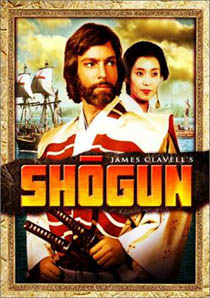
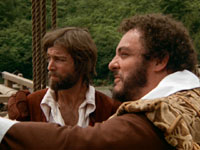 While I'm normally not a big fan of TV shows on DVD,
particularly when the show has not even finished its run on television, in the case of a
miniseries as significant as "Shogun", I was more than enthusiastic when I
heard it was coming to DVD. Paramount has delivered an exquisite
edition of this classic, with all nine hours spanned over four discs, plus a
fifth devoted to extra material. Clearly a must have for any
collector.
While I'm normally not a big fan of TV shows on DVD,
particularly when the show has not even finished its run on television, in the case of a
miniseries as significant as "Shogun", I was more than enthusiastic when I
heard it was coming to DVD. Paramount has delivered an exquisite
edition of this classic, with all nine hours spanned over four discs, plus a
fifth devoted to extra material. Clearly a must have for any
collector.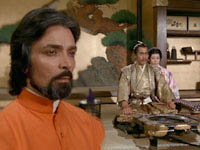 Of
the countless efforts to turn a great book into film, precious few succeed
on any level, let alone take on a literary status commensurate with their
muse. Shogun is one such few which transcends all the pitfalls and is
remembered as a tremendous epic piece of motion picture art.
Of
the countless efforts to turn a great book into film, precious few succeed
on any level, let alone take on a literary status commensurate with their
muse. Shogun is one such few which transcends all the pitfalls and is
remembered as a tremendous epic piece of motion picture art.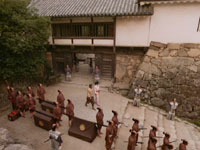 Though
Richard Chamberlain will of course always be remembered as the face of the
Shogun saga, more credit is perhaps due Yoko Shimada for her pivotal
roll in the picture as well as Toshiro Mifune's engaging performance as
Toranaga.
John Rhys Davies, veritably launched by Shogun, has gone on to be a staple
of important projects from Steven Spielberg's works, to the other James Clavell mini
series Nobel House, to the instant classic Lord of the Rings.
Though
Richard Chamberlain will of course always be remembered as the face of the
Shogun saga, more credit is perhaps due Yoko Shimada for her pivotal
roll in the picture as well as Toshiro Mifune's engaging performance as
Toranaga.
John Rhys Davies, veritably launched by Shogun, has gone on to be a staple
of important projects from Steven Spielberg's works, to the other James Clavell mini
series Nobel House, to the instant classic Lord of the Rings.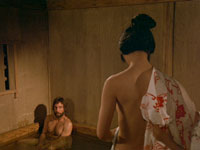 But
perhaps
the best reason to own this piece after all is the story, presented with a
depth only nine hours of screen time can achieve. We look at a culture
so vastly different through the experiences of a foreigner, and learn as he
learns. At no time is the language barrier glossed over. The
movie tediously and deliberately spends a lot of precious time playing out
the translations and interpretation which has to be done for the Blackthorn
character. In so doing, we feel the alienation that he feels.
But
perhaps
the best reason to own this piece after all is the story, presented with a
depth only nine hours of screen time can achieve. We look at a culture
so vastly different through the experiences of a foreigner, and learn as he
learns. At no time is the language barrier glossed over. The
movie tediously and deliberately spends a lot of precious time playing out
the translations and interpretation which has to be done for the Blackthorn
character. In so doing, we feel the alienation that he feels. There
is a making of documentary divided into 13 segments with a running time
of over a hour. It is comprised of precious few behind the scenes
visuals and interviews done in recent years, interwoven
with footage from the movie. It is well edited and sufficiently
interesting to warrant a watch.
There
is a making of documentary divided into 13 segments with a running time
of over a hour. It is comprised of precious few behind the scenes
visuals and interviews done in recent years, interwoven
with footage from the movie. It is well edited and sufficiently
interesting to warrant a watch.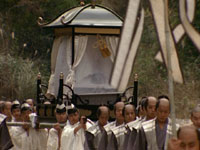 Oh yes, there is also the trailer for the Indiana Jones Trilogy DVD, coming
in November.
Oh yes, there is also the trailer for the Indiana Jones Trilogy DVD, coming
in November.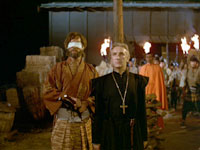 There is some obvious effort to smooth things out in terms of dynamic range
and color. For the most part, there is consistency in this regard with
half decent blacks and grays with a color channel that is not all over the
place.
There is some obvious effort to smooth things out in terms of dynamic range
and color. For the most part, there is consistency in this regard with
half decent blacks and grays with a color channel that is not all over the
place.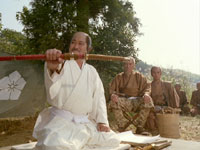 We only pulled the MPEG PIC data from disc one, as the other three are bound
to be commensurate with it.
We only pulled the MPEG PIC data from disc one, as the other three are bound
to be commensurate with it.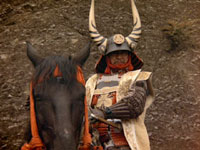 You get two flavors of English
here: a new 5.1 remix and "restored" mono. While I normally
count myself as a purist, here I don't mind opting for the 5.1 as it really is
not that much of a reinterpretation. For the most part it consists only of redistributing the musical score
back to its native stereo, all
the while keeping the rest of the soundtrack in the center. Naturally,
ambient cues (wind, waves, earth quake rumbles, etc.) break out to all channels, something that can
only add to the efforts of the original sound artist. Whether 5.1
or mono, the track is surprisingly clean, with virtually no hiss or
distortion such as mic preamp clipping. However, there is a noticeable
lack of dynamic range which is not a fault, given that the original track
was intended for tiny TV speakers. Rather its just an observation of
what to expect.
You get two flavors of English
here: a new 5.1 remix and "restored" mono. While I normally
count myself as a purist, here I don't mind opting for the 5.1 as it really is
not that much of a reinterpretation. For the most part it consists only of redistributing the musical score
back to its native stereo, all
the while keeping the rest of the soundtrack in the center. Naturally,
ambient cues (wind, waves, earth quake rumbles, etc.) break out to all channels, something that can
only add to the efforts of the original sound artist. Whether 5.1
or mono, the track is surprisingly clean, with virtually no hiss or
distortion such as mic preamp clipping. However, there is a noticeable
lack of dynamic range which is not a fault, given that the original track
was intended for tiny TV speakers. Rather its just an observation of
what to expect.

